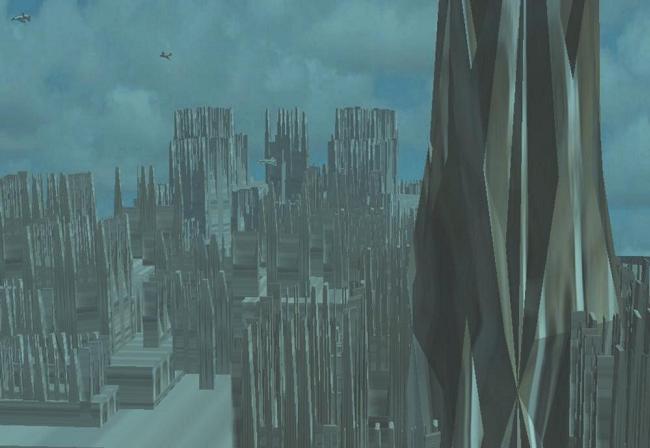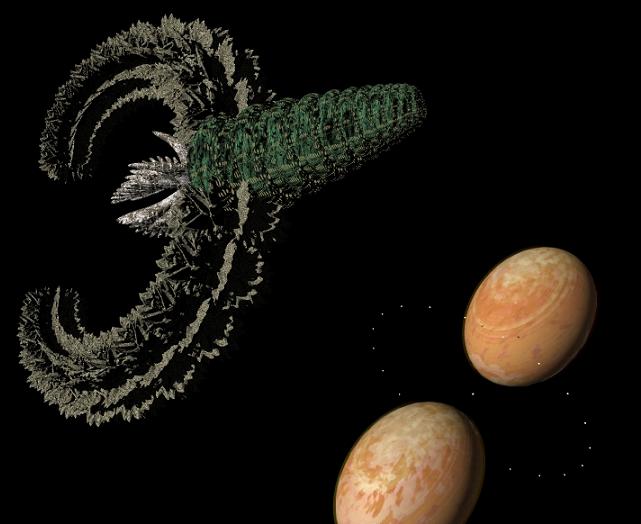BY LETTER
Maximalism
Culture and Society > Fine Arts > Architecture
Culture and Society > Fine Arts > Classical Studies
Culture and Society > Fine Arts
Culture and Society > Fine Arts > Classical Studies
Culture and Society > Fine Arts
 Image from Steve Bowers | |
| Maximal City, an example of maximalistic architecture on Barzelona | |
Maximalism is a general term for the dominant modes of design that arose in the middle decades of the Information Age and lasted well into the Solsys Golden Age. It was the eventual successor of the Modernism and Postmodernism of the late Industrial Age and early Information Age. Like them, it covered a multitude of schools and styles, was expressed all the various aspects of the fine and practical arts, from architecture, city planning, landscaping, painting, graphic art, and industrial design, and had echoes in other fields such as literature and the performance arts. It is not to be confused with some similar, minor Post-Modernist schools of art, also called Maximalism, that arose in the early Information Age, especially in China and parts of the Far East. As in the case of true Maximalism, some aspects of Modernism, and in particular its Minimalist aspects were rejected by these artists and designers sought new realms, but those early "Maximalists" are now seen as at most precursors of the true Maximalist schools now recognised by art historians. The various schools of art that are now called Maximalist were not merely a reaction to early first century AT minimalism, but instead arose as a direct result of new information and biological, and early bionano technologies and their influence on the art and culture of the day.
In the later Industrial Age, diverse fields from literature and the fine arts to architecture and city planning had been influenced by new bulk materials, mass production, technologies of speed, and a philosophical impulse to explore the physical and sensory components of art. The resulting Modernist schools of art laid an emphasis on clean lines, fundamental forms, and an exposure of underlying structures both physical and memetic. They also imitated some of the new rapid land and air transport technologies, sometimes even to the extent of "streamlining" buildings or stationary appliances after the fashion of high speed ground or air vehicles, or self-consciously exposing physical supports in a building or narrative structure in a story. This trend declined gradually in the early first century AT, but it did not develop a clear successor until the impact of new information, biological, and early nanotech technologies made attention to extremely fine detail possible: sentient level AI attending to subroutines, automation, microscale and nanoscale control of processes. Abundant free time (sometimes enforced free time due to unemployment), and a broadened audience due to the emerging precursor to the Known Net also made a return to detail and intricacy in design possible, but it was the new technologies that made them not only possible but new, exciting, and modish. Like Modernism, Maximalism was seen as new and advanced, and related to the cutting edge of technology; Modernist forms came to be seen as primitive and old fashioned.
The "look" of Maximalism hearkened back in some ways to much older art forms such as Islamic mosaics and calligraphy, Celtic knot designs, Gothic European art and stonework, some Ming Era Chinese art, and certain elements of Southeast Asian Balinese or ancient Central American design, but it was entirely new in its approach. The first elements of the emerging new style could be seen in the "New Mayan" and "Indiolatino" schools that emerged in the tropical regions of the Americas in the early Second Century AT as the biotech revolution took hold. However many art historians believe the essence of the new dynamism was first fully expressed by Sanaa Kisasa (Sheng for "new art"), a syncretic style developed by artists, architects and artisans in New Nairobi around the base of the East African beanstalk. Subsequent Biomimist, Elaborationist, and Novagothic movements built on the dynamism of the African and Central American schools. They spread, first to the other Beanstalk cities and orbital habs and then to the older and more backward polities of Europe, North America, and northern Asia. Short-lived fads such as the Nuthouse or Fractal Gargoyle movements came and went with startling rapidity, while true innovation continued to grow right through to the beginning of the Technocalypse. Maximalism was important all through Solsys by this time, and was carried to the first interstellar colonies, where it mutated yet again into newer forms. Likewise Maximalist-influenced designs developed independently in the isolated habs and colonies within Solsys during the Technocalypse Era itself. Maximalism showed one last burst of exuberance in the early First Federation, before it was overtaken by a welter of competing movements, many of which associated Maximalism with the Technocalypse Dark Ages, and advocated a return to cleaner more "classical" designs in art. It is true that some of the later works of the Maximalist era tended towards pointless elaboration, useless accretions, and strangeness to the point of the grotesque. That was indeed its reputation for a considerable period following its fall from favour. Later eras have rediscovered the freshness and beauty of the original movement, and there have been numerous Maximalist-inspired "revivals" in parts of the Terragen sphere ever since.
The rise, long reign, and eventual decline of Maximalism marked the last time that Terragens could be said to follow a single overall aesthetic, however diverse and diffuse. The trend over the course of the Agricultural and Industrial ages had been towards the elimination and fusion of regional styles, culminating in world-wide and eventually system-wide cultures. However in later periods the new diversity of clades and cultures, the separation of various Terragen groups by interstellar distances and relativistic travel, and the sheer memetic inertia of the huge new populations of humanity and post-humanity in so many diverse locations have prevented a single memeplex from ever again having such broad influence, even among cultures and polities thoroughly connected to the Known Net and the Wormhole Network.
The greatest works of Maximalist art are now widely replicated, but the originals are all generally to be found in that narrow portion of the Inner Sphere that represented the limit of Terragen expansion at the time of the First Federation. Solsys in particular is home to some splendid examples; among the most notable of these are the Paradise Parks on Luna, and the ancient cathedrals of the Evangelical Orthodox Catholic Christians in some of the habs orbiting Saturn. Outside of Solsys, many Etodist settlements have fine examples of Maximalist art, as do the early colonial settlements on Penglai (where the neo-Taoist "Four Dragons" carried out much of their work). The oldest Beneficence habs at Ao Lai, and the various structures and artworks therein, are also fine examples of early and middle Maximalism.
Various movements reminiscent of Maximalism have arisen again in particular systems, or even over broad portions of the Terragen sphere. The Abergists are one such example. The first contacts with To'ul'h cultures brought about a widespread resurgence of Maximalist design when the "Nature Echoes" movement, based on To'ul'h touch-carvings, swept human and other biont cultures. Most recently many vec cultures have taken up designs reminiscent of Maximalism under the influence of new information flowing from researches at Stanislaw. In general, bioist cultures are the most prone to designs reminiscent of Maximalism; both direct and indirect descendants of various Maximalist schools (especially Biomimists) are common areas of the Zoeific Biopolity to this day.
 Image from Anders Sandberg | |
| The maximalist and baroque structures left behind by the vanished Vore Abergist society in the Bill and Bull system | |
Related Articles
Appears in Topics
Development Notes
Text by Stephen Inniss
Initially published on 04 July 2006.
Initially published on 04 July 2006.






